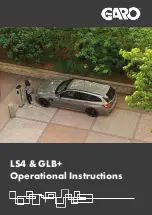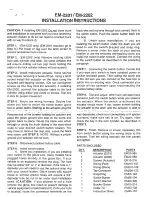
Snow chains
!
Vehicles with Adaptive Damping System
(ADS):
When driving with snow chains, do not
select
SPORT mode as this may result in
damage to your vehicle.
!
Some tire sizes do not leave adequate
clearance for snow chains. To help avoid
serious damage to your vehicle or tires,
make sure the use of snow chains is
permissible as specified in the “Technical
data” section of this Operator’s Manual.
Snow chains should only be driven on snow-
covered roads at speeds not to exceed
30 mph (50 km/h). Remove chains as soon
as possible when driving on roads without
snow.
Observe the following guidelines when using
snow chains:
R
Use of snow chains is not permissible with
all wheel/tire combinations (
Y
page 347).
R
Use snow chains in pairs and on rear
wheels only. Follow the manufacturer’s
mounting instructions.
!
If snow chains are mounted to the front
wheels, they may scrape against the body
or axle components. The tires or the vehicle
could be damaged as a result.
R
Only use snow chains that are approved by
Mercedes-Benz. Any authorized Mercedes-
Benz Center will be glad to advise you on
this subject.
R
Use of snow chains may be prohibited
depending on location. Always check local
and state laws before installing snow
chains.
R
Do not use snow chains on the spare wheel.
i
When driving with snow chains, you may
wish to switch off the ESP
®
(
Y
page 65)
before setting the vehicle in motion. This
will improve the vehicle’s traction.
Winter driving instructions
G
Warning!
If the vehicle becomes stuck in snow, make
sure snow is kept clear of the exhaust pipe
and from around the vehicle with the engine
running. Otherwise, deadly carbon monoxide
(CO) gases may enter vehicle interior
resulting in unconsciousness and death.
To assure sufficient fresh air ventilation, open
a window slightly on the side of the vehicle
not facing the wind.
G
Warning!
The outside temperature indicator is not
designed to serve as an ice-warning device
and is therefore unsuitable for that purpose.
Indicated temperatures just above the
freezing point do not guarantee that the road
surface is free of ice. The road may still be icy,
especially in wooded areas or on bridges.
G
Warning!
On slippery road surfaces, never downshift in
order to obtain braking action. This could
result in drive wheel slip and reduced vehicle
control. Your vehicle’s ABS will not prevent
this type of loss of control.
The most important rule for slippery or icy
roads is to drive sensibly and to avoid abrupt
acceleration, braking and steering
maneuvers. Do not use the cruise control
system under such conditions.
When the vehicle is in danger of skidding, shift
the automatic transmission to neutral
position
N. Try to keep the vehicle under
control by corrective steering action.
i
For information on driving with snow
chains, see “Snow chains” (
Y
page 252).
Road salts and chemicals can adversely
affect braking efficiency. Increased pedal
force may become necessary to produce the
normal brake effect.
Depressing the brake pedal periodically when
traveling at length on salt-strewn roads can
252
Winter driving
Operation
251_AKB; 4; 52, en-US
d2ureepe,
Version: 2.11.8.1
2009-03-23T09:22:52+01:00 - Seite 252
Summary of Contents for 2010 R-Class
Page 4: ...251_AKB 4 52 en US d2ureepe Version 2 11 8 1 2009 03 23T09 22 52 01 00 Seite 2...
Page 36: ...34 251_AKB 4 52 en US d2ureepe Version 2 11 8 1 2009 03 23T09 22 52 01 00 Seite 34...
Page 220: ...218 251_AKB 4 52 en US d2ureepe Version 2 11 8 1 2009 03 23T09 22 52 01 00 Seite 218...
Page 360: ...358 251_AKB 4 52 en US d2ureepe Version 2 11 8 1 2009 03 23T09 22 52 01 00 Seite 358...
Page 361: ...359 251_AKB 4 52 en US d2ureepe Version 2 11 8 1 2009 03 23T09 22 52 01 00 Seite 359...
Page 362: ...360 251_AKB 4 52 en US d2ureepe Version 2 11 8 1 2009 03 23T09 22 52 01 00 Seite 360...
















































